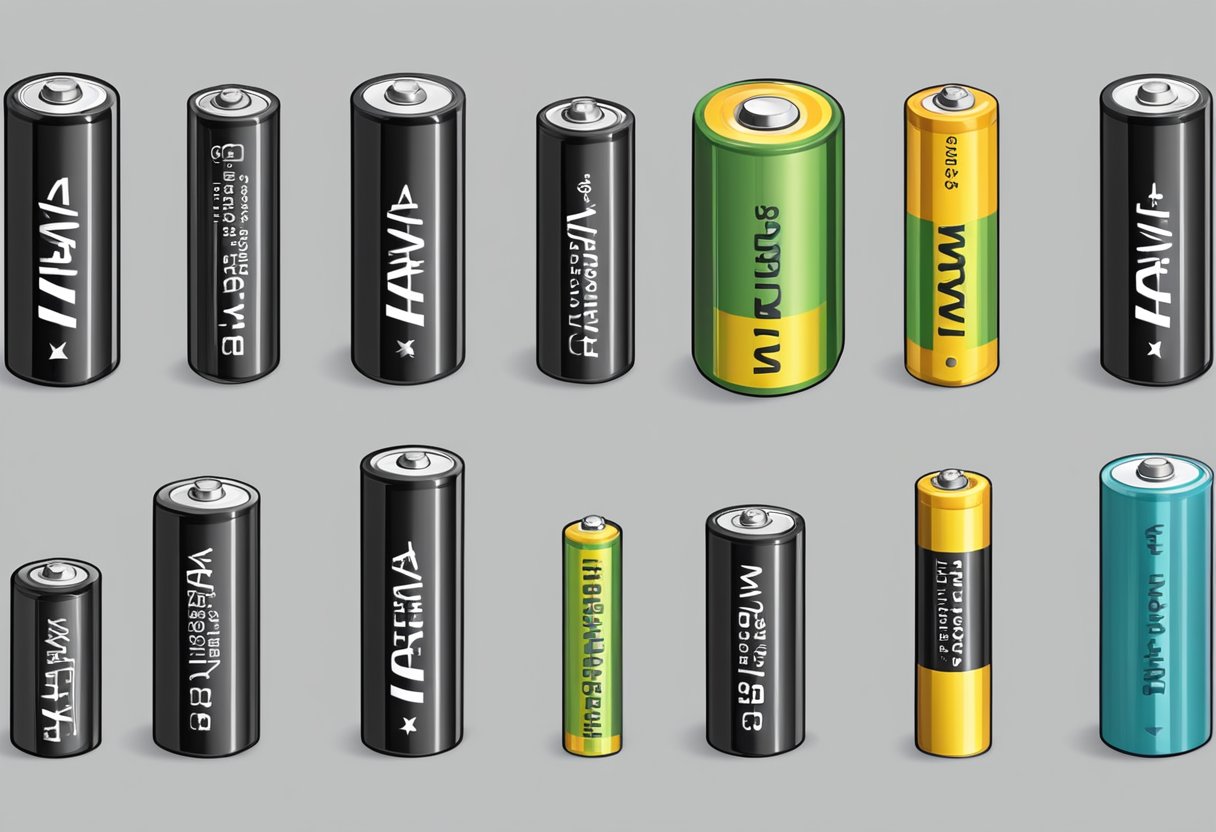Types Of Batteries
Batteries are an essential component of our daily lives, powering everything from our smartphones to our cars. However, not all batteries are created equal, and understanding the different types of batteries available is crucial to selecting the right one for your needs.

Battery Basics
At their core, batteries are electrochemical devices that convert chemical energy into electrical energy. They consist of one or more cells, each containing an anode, a cathode, and an electrolyte. When a load is connected to the battery, electrons flow from the anode to the cathode, producing a flow of electrical current.
Primary and Secondary Batteries
Primary batteries, also known as disposable batteries, are designed for one-time use and cannot be recharged. They are commonly used in low-drain devices such as remote controls, flashlights, and smoke detectors. In contrast, secondary batteries, also known as rechargeable batteries, can be recharged and used multiple times. They are typically more expensive than primary batteries but offer a lower cost per use over their lifetime.
Key Takeaways
- Batteries are electrochemical devices that convert chemical energy into electrical energy.
- Primary batteries are disposable and cannot be recharged, while secondary batteries are rechargeable and can be used multiple times.
- Understanding the different types of batteries available is crucial to selecting the right one for your needs.
Battery Basics
Batteries are devices that store and release electrical energy through chemical reactions. They are commonly used in portable electronic devices such as smartphones, laptops, and cameras, as well as in automobiles and other applications. In this section, we will discuss the basics of batteries, including chemical reactions, voltage and current, anode and cathode.
Chemical Reactions
Batteries work by converting chemical energy into electrical energy. This process involves a chemical reaction between the battery’s electrolyte and its electrodes. The electrolyte is a substance that conducts electricity, while the electrodes are materials that can undergo a chemical reaction to produce or consume electrons.
Voltage and Current
The voltage of a battery is a measure of its electrical potential, or the difference in electrical charge between its positive and negative terminals. The current is the flow of electrical charge through the battery, from the negative to the positive terminal. Batteries can produce either direct current (DC) or alternating current (AC), depending on their design.
Anode and Cathode
The anode and cathode are the two electrodes in a battery. The anode is the electrode where oxidation occurs, meaning that it loses electrons. The cathode is the electrode where reduction occurs, meaning that it gains electrons. The flow of electrons between the anode and cathode generates the electrical current.
Overall, batteries are essential components in many electronic devices and applications. Understanding the basics of batteries, including their chemical reactions, voltage and current, anode and cathode, can help in selecting the right battery for a specific application.
Primary and Secondary Batteries
Batteries can be classified into two main categories: primary and secondary batteries. Primary batteries are non-rechargeable, disposable batteries that are designed for single use. Secondary batteries, on the other hand, are rechargeable batteries that can be used multiple times.
Alkaline Batteries
Alkaline batteries are a type of primary battery that are commonly used in household devices such as remote controls, flashlights, and portable radios. They are known for their long shelf life and high energy density. Alkaline batteries are also relatively inexpensive and widely available.
Lithium Batteries
Lithium batteries are a type of primary battery that are commonly used in devices that require a high amount of power, such as digital cameras, handheld gaming consoles, and medical devices. They are known for their high energy density, long shelf life, and ability to operate in extreme temperatures. Lithium batteries are also lightweight and have a low self-discharge rate.
Zinc-Carbon Batteries
Zinc-carbon batteries are a type of primary battery that are commonly used in low-drain devices such as flashlights, remote controls, and wall clocks. They are known for their low cost and availability. Zinc-carbon batteries have a lower energy density and shorter shelf life compared to alkaline and lithium batteries.
In summary, primary batteries are non-rechargeable, disposable batteries that are designed for single use. Alkaline, lithium, and zinc-carbon batteries are all examples of primary batteries. Alkaline batteries are commonly used in household devices, lithium batteries are commonly used in high-drain devices, and zinc-carbon batteries are commonly used in low-drain devices.
Rechargeable Battery Types
Rechargeable batteries are becoming increasingly popular due to their ability to be recharged and reused multiple times, making them more cost-effective and environmentally friendly than disposable batteries. There are several types of rechargeable batteries available, each with its own advantages and disadvantages.
Nickel-Cadmium Batteries
Nickel-Cadmium (NiCd) batteries are one of the oldest rechargeable battery types and are known for their high capacity and long cycle life. They are commonly used in power tools, emergency lighting, and other high-drain devices. However, they are also known for their “memory effect,” which can reduce their capacity over time if they are not fully discharged before recharging.
Nickel-Metal Hydride Batteries
Nickel-Metal Hydride (NiMH) batteries have a higher capacity than NiCd batteries and are less prone to the memory effect. They are commonly used in digital cameras, portable audio devices, and other consumer electronics. However, they have a shorter cycle life than NiCd batteries and can lose their charge quickly when not in use.
Lithium-Ion Batteries
Lithium-Ion (Li-ion) batteries are the most common rechargeable battery type used in smartphones, laptops, and other portable devices. They have a high energy density, which means they can store more energy in a smaller size. They also have a long cycle life and are less prone to the memory effect. However, they can be expensive and require special care when charging and discharging to avoid damaging the battery.
Lead-Acid Batteries
Lead-Acid batteries are commonly used in vehicles, backup power systems, and other high-power applications. They are known for their high capacity and low cost, but they are also heavy and require regular maintenance. They are not as commonly used in consumer electronics due to their size and weight.
Overall, the choice of rechargeable battery type depends on the specific application and requirements. Capacity, cycle life, memory effect, and cost are all important factors to consider when choosing a rechargeable battery.
Battery Performance and Specifications
Batteries come in different shapes, sizes, and chemical compositions. They are designed to provide a reliable and consistent source of power for various applications. The performance of a battery is determined by its specifications, which include capacity, energy density, shelf life, self-discharge rate, temperature, watt-hour, load current, and high discharge rates. Understanding these specifications is crucial when choosing the right battery for a particular application.
Capacity and Energy Density
Battery capacity is the amount of charge that a battery can store and deliver. It is usually measured in ampere-hours (Ah) or milliampere-hours (mAh). Energy density, on the other hand, is a measure of the amount of energy that a battery can store per unit volume or weight. It is usually measured in watt-hours per liter (Wh/L) or watt-hours per kilogram (Wh/kg). Batteries with high energy density can store more energy in a smaller size or weight, making them ideal for portable devices.
Shelf Life and Self-Discharge
Shelf life is the length of time that a battery can be stored without losing its capacity. It is affected by factors such as temperature, humidity, and the type of battery. Self-discharge rate is the rate at which a battery loses its charge when not in use. Batteries with low self-discharge rates can be stored for longer periods without losing their charge. Lithium-ion batteries, for example, have a longer shelf life and lower self-discharge rate than other types of batteries.
Temperature Effects
Temperature has a significant effect on battery performance. High temperatures can reduce battery life and cause damage to the battery. Low temperatures can also reduce battery capacity and increase its internal resistance, making it difficult to deliver high currents. It is essential to choose a battery that can operate within the required temperature range for a particular application.
In conclusion, battery performance and specifications are critical factors to consider when selecting the right battery for a particular application. Capacity, energy density, shelf life, self-discharge rate, temperature, watt-hour, load current, and high discharge rates are some of the essential specifications to consider. By understanding these specifications, one can make an informed decision when choosing a battery that will provide reliable and consistent power for their application.
Applications and Considerations
Batteries are widely used in various applications, ranging from consumer electronics to electric vehicles and renewable energy systems. Each type of battery has its own advantages and disadvantages, making it suitable for specific applications. In this section, we will discuss the applications and considerations for different types of batteries.
Consumer Electronics
Consumer electronics, including portable electronic devices, appliances, and gadgets, require small and lightweight batteries that are cost-effective and convenient. AA, AAA, coin cell, and button cell batteries are commonly used in these applications. AA and AAA batteries are widely used in remote controls, toys, and flashlights, while coin cell and button cell batteries are used in watches, calculators, and hearing aids.
Electric Vehicles
Electric vehicles require high-energy density batteries that can provide long-range driving and fast charging. Lithium-ion batteries are currently the most commonly used batteries in electric vehicles due to their high energy density, low self-discharge rate, and long cycle life. However, they are relatively expensive and require careful handling to prevent thermal runaway.
Renewable Energy Systems
Renewable energy systems, including solar and wind power systems, require deep-cycle batteries that can store energy for extended periods. Lead-acid batteries are commonly used in these applications due to their low cost, high reliability, and ability to withstand deep discharge cycles. However, they are relatively heavy and require regular maintenance to ensure their performance.
In conclusion, selecting the right type of battery for a specific application requires careful consideration of its advantages and disadvantages. It is essential to choose a battery that can meet the energy requirements of the application while being cost-effective, reliable, and safe to use.






